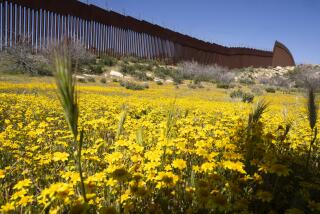Guayule Has a History of Ups and Downs
- Share via
The 16,000 acres of guayule that a Ventura County man claims to have planted amounts to more than 20 times the total known by agricultural and rubber industry experts to be growing in the United States.
Despite millions of dollars spent in recent years on guayule research, only about 700 to 800 acres of the plant are being cultivated, most of it on an experimental basis under government contract, experts say.
Although tire companies and military officials hope that guayule will someday provide an alternative to the 840,000 metric tons of natural rubber imported by the United States each year, they say the small tumbleweed-like shrub simply produces too little latex for the cost of planting and processing it.
“It just cannot make it on its own yet,” said Ali Estilai, past president of the Guayule Rubber Society and an agronomist at UC Riverside, where the botany department publishes a quarterly newsletter, El Guayulero.
Nonetheless, the plant, known as Parthenium argentatum , has enjoyed a rather illustrious history, blossoming particularly during wartime rubber shortages.
A 3-foot-high shrub native to the arid plateaus of Texas and northern Mexico, the guayule proved its usefulness as far back as the 1500s when Spanish conquistadors found Aztecs playing with rubber balls made from the chewed plant.
In the early 1900s, a group of American industrialists, including John D. Rockefeller, invested $30 million in a guayule firm, the Continental-Mexican Rubber Co. By 1910, about 50% of U.S. rubber was being extracted from wild guayule growing near the border.
However, poor farming methods and revolution in Mexico soon contributed to the downturn of the industry.
In 1930, Dwight D. Eisenhower, then a young Army major, issued a report recommending that guayule be cultivated for emergency use, but, by then, Southeast Asia’s abundant rubber trees were already providing a cheaper alternative.
It was not until World War II, when the Japanese seized the Asian rubber plantations, that guayule caught on again. A massive Emergency Rubber Project started in 1942 brought together more than 1,000 scientists, 9,000 laborers and 32,000 acres of the spiky, blue-gray shrub.
Much of the guayule was grown in Central California and, after a few years, 15 tons of rubber were being produced daily at processing plants in Salinas and Bakersfield.
But with the end of the war and the advent of synthetic substitutes, that brief heyday also went by the wayside.
Today, the country’s guayule capital is Sacaton, Ariz., where, under a Navy-sponsored program, the Gila River Indians grow about 400 acres of the plant. Last year, Firestone Rubber & Tire Co. began construction of an $8-million processing facility at the site.
While some industry experts are hopeful that the Gila River experiment will provide the roots for a guayule rebound, the world’s largest consumer of natural rubber, the Goodyear Tire & Rubber Co., has all but given up on the idea.
“You can’t do it and make a buck,” said Hank Inman, a Goodyear spokesman. “Good luck to the guy who says he can. But I think he’s dreaming.”
More to Read
Sign up for Essential California
The most important California stories and recommendations in your inbox every morning.
You may occasionally receive promotional content from the Los Angeles Times.













